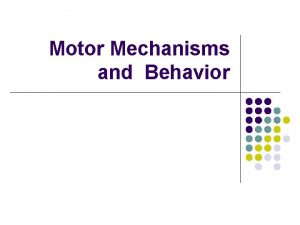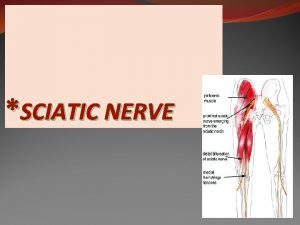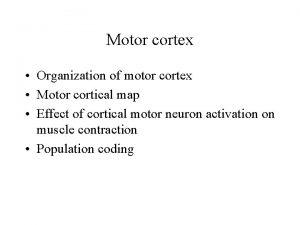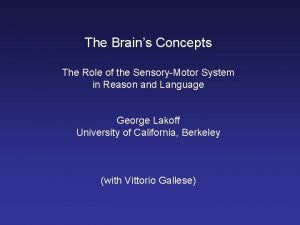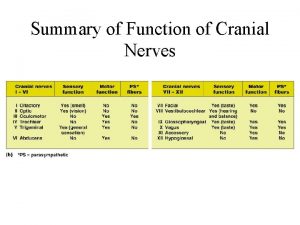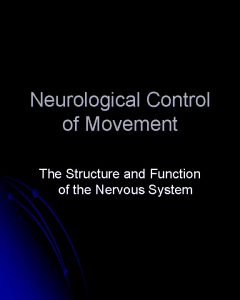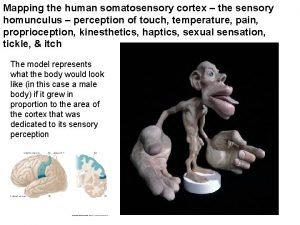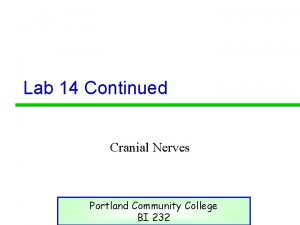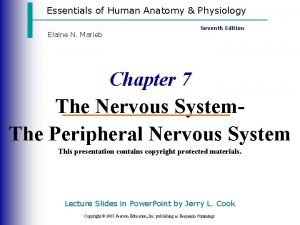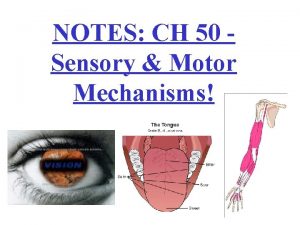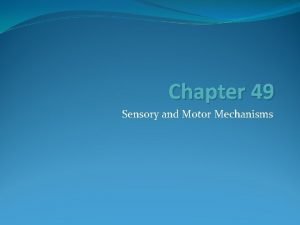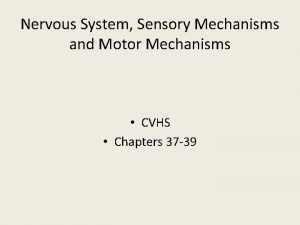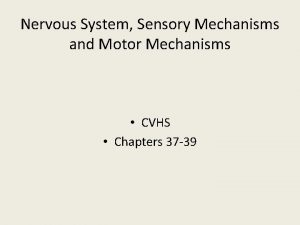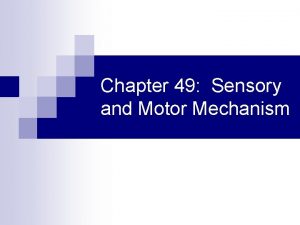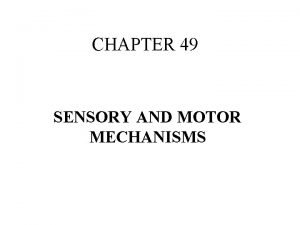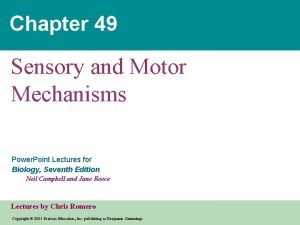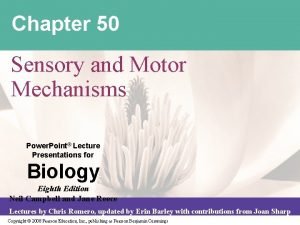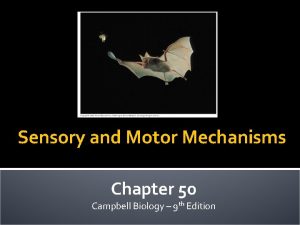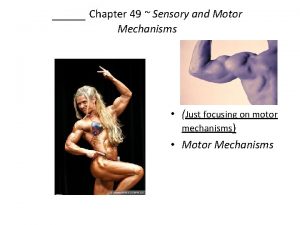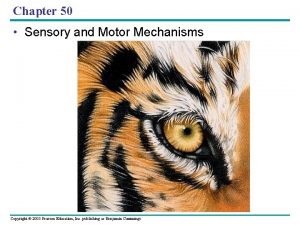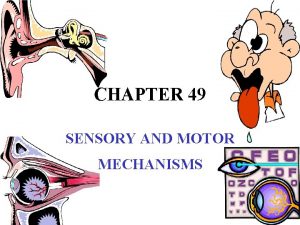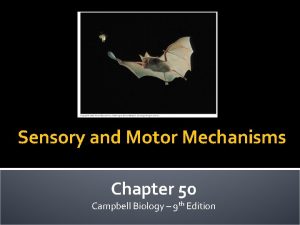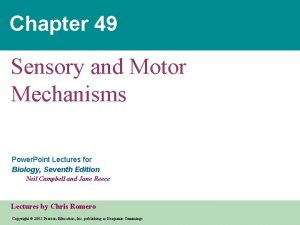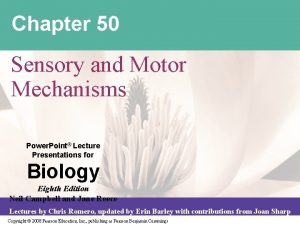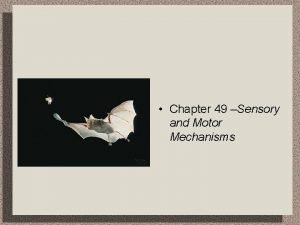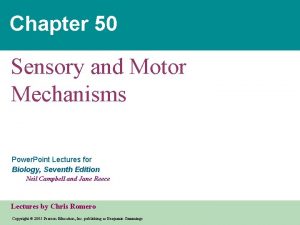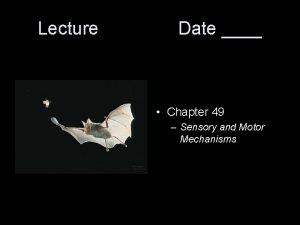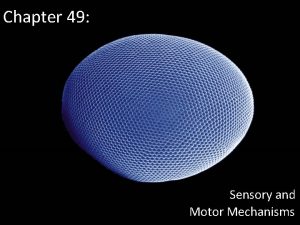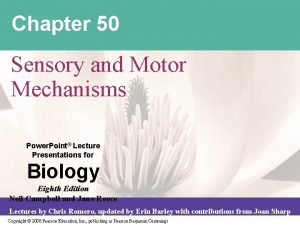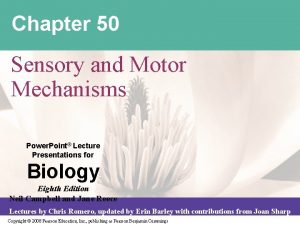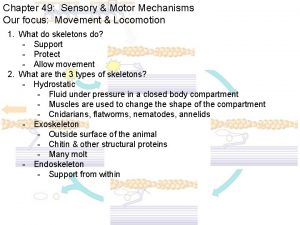Sensory and Motor Mechanisms Chapter 49 Sensory and
























- Slides: 24

Sensory and Motor Mechanisms Chapter 49

Sensory and motor mechanisms • • Sensory receptors in general - transduction Sound receptors - the cochlea and pitch Chemoreceptors - insect pheromones Electromagnetic receptors - migration

Functions Performed by Sensory Receptors • All stimuli represent forms of energy • Sensation involves converting energy into change in the membrane potential of sensory receptors • Functions of sensory receptors: sensory transduction, amplification, transmission, and integration

LE 49 -2 a Sensory reception: crayfish stretch receptors - Fig. 99. 2 a Weak muscle stretch Muscle Stretch receptor Membrane potential (m. V) Dendrites Axon – 50 Receptor potential – 50 – 70 Action potentials 0 0 – 70 0 1 2 3 4 5 6 7 Time (sec) Crayfish stretch receptors have dendrites embedded in abdominal muscles. When the abdomen bends, Strong muscle stretch muscles and dendrites stretch, producing a receptor potential in the stretch receptor. The receptor potential triggers action potentials 0 1 2 3 4 5 6 7 Time (sec) in the axon of the stretch receptor. A stronger stretch produces a larger receptor potential and higher frequency of action potentials.

Sensory reception: vertebrate hair cells - Fig. 99. 2 b No fluid movement “Hairs” of hair cell Fluid moving in one direction More neurotransmitter Neurotransmitter at synapse Less neurotransmitter – 50 Receptor potential – 70 Action potentials 0 – 70 Membrane potential (m. V) – 50 Membrane potential (m. V) Axon Fluid moving in other direction – 70 0 Vertebrate hair cells have specialized cilia or microvilli (“hairs”) that bend when surrounding fluid moves. Each hair cell releases an excitatory neurotransmitter 0 – 70 0 1 2 3 4 5 6 7 Time (sec) at a synapse with a sensory neuron, which conducts action potentials to the CNS. Bending in one direction depolarizes the hair cell, causing it to release more 0 1 2 3 4 5 6 7 Time (sec) neurotransmitter and increasing frequency of action potentials in the sensory neuron. Bending in the other direction has the opposite effects. Thus, hair cells respond to the direction of motion as well as to its strength and speed.

Sensory and motor mechanisms • • Sensory receptors in general - transduction Sound receptors - the cochlea and pitch Chemoreceptors - insect pheromones Electromagnetic receptors - migration

Transduct -ion in the cochlea -Fig. 49. 8

Transduct -ion in the cochlea -Fig. 49. 8

Transduct -ion in the cochlea -Fig. 49. 8

Transduct -ion in the cochlea -Fig. 49. 8

Transduct -ion in the cochlea -Fig. 49. 8

Transduction in the cochlea -- Fig. 49. 9 Cochlea Stapes Vestibular canal Oval window Perilymph Apex Base Round window Tympanic canal Axons of sensory neurons Basilar membrane

Sensing pitch in the cochlea -Fig. 49. 10 Cochlea (uncoiled) Basilar membrane Apex (wide and flexible) 500 Hz (low pitch) 8 k. Hz 16 k. Hz (high pitch) Base (narrow and stiff) 1 k. Hz 2 k. Hz 4 k. Hz Frequency producing maximum vibration

Sensory and motor mechanisms • • Sensory receptors in general - transduction Sound receptors - the cochlea and pitch Chemoreceptors - insect pheromones Electromagnetic receptors - migration

text

Chemoreceptors in a silkworm moth - Fig. 49. 4

The pheromones and the protein that binds them are known

text

Sensory and motor mechanisms • • Sensory receptors in general - transduction Chemoreceptors - insect pheromones Sound receptors - the cochlea and pitch Electromagnetic receptors - migration

Electromagnetic receptors - beluga whales migrating

a molecular profile for the baluga whale…

Trout have magnets in their noses. magnet response of individual particles

Magnetotactic bacteria synthesize magentite in membrane-bound vesicles – the vesicles align to make a compass. One cell One string of vesicles

Sensory and motor mechanisms • • Sensory receptors in general - transduction Chemoreceptors - insect pheromones Sound receptors - the cochlea and pitch Electromagnetic receptors - migration
 Sensory and motor mechanism
Sensory and motor mechanism Lateral strabismus cranial nerve
Lateral strabismus cranial nerve Foramen interventriculare
Foramen interventriculare Cranial nerves sensory and motor
Cranial nerves sensory and motor Sensory input and motor output
Sensory input and motor output Motor and sensory cranial nerves
Motor and sensory cranial nerves Motor and sensory nerve
Motor and sensory nerve Incoming sensory impulses and outgoing motor impulses
Incoming sensory impulses and outgoing motor impulses Sciatic nerve and its branches
Sciatic nerve and its branches Cn i
Cn i Motor cortex sensory cortex
Motor cortex sensory cortex Sensory vs motor homunculus
Sensory vs motor homunculus Sensory-motor
Sensory-motor Sensory cranial nerves
Sensory cranial nerves Sensory-motor
Sensory-motor What is a homunculus
What is a homunculus Glossopharyngeal nerve assessment
Glossopharyngeal nerve assessment Cranial nerve number face
Cranial nerve number face A motor unit is
A motor unit is Pony motor starting method
Pony motor starting method Synchronous motor hunting
Synchronous motor hunting Motor parts name
Motor parts name Pony motor starting synchronous motor
Pony motor starting synchronous motor Chapter 15 microbial mechanisms of pathogenicity
Chapter 15 microbial mechanisms of pathogenicity Chapter 15 microbial mechanisms of pathogenicity
Chapter 15 microbial mechanisms of pathogenicity
